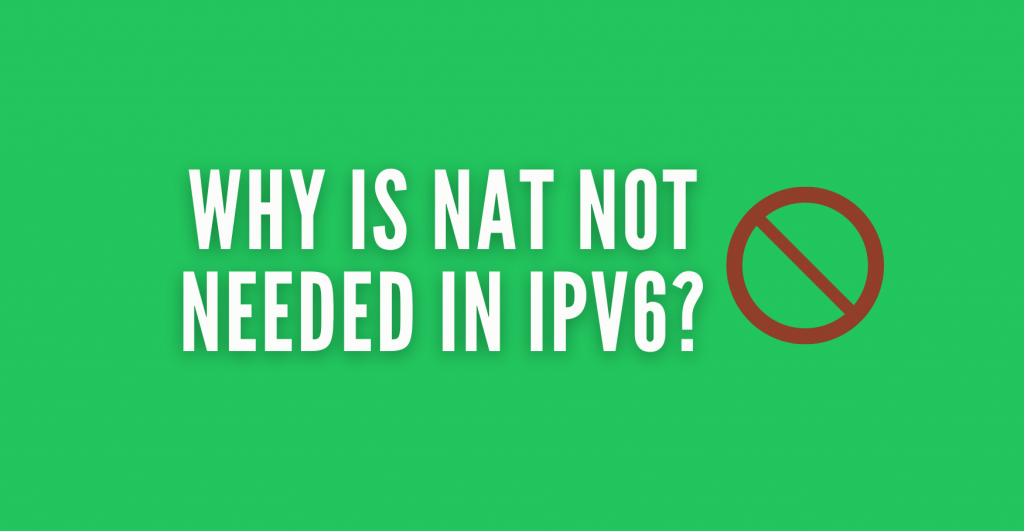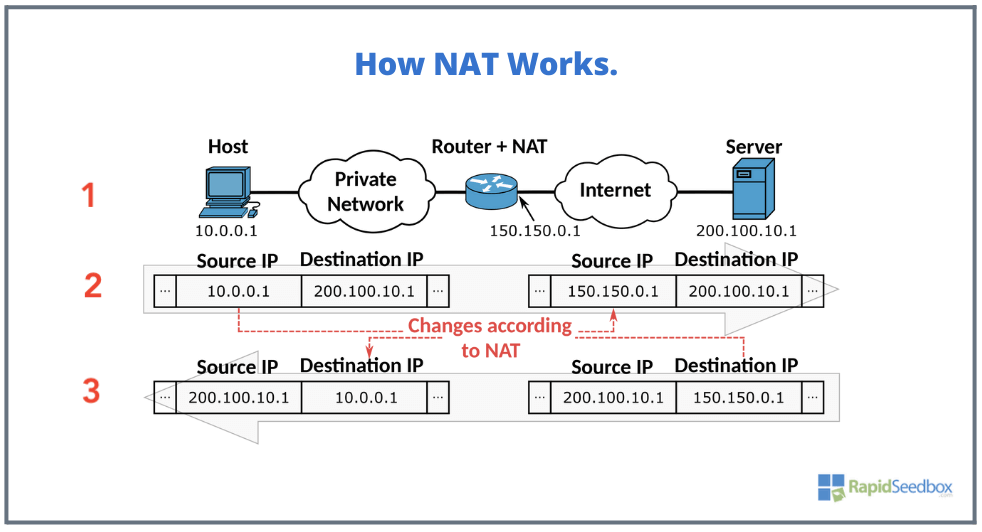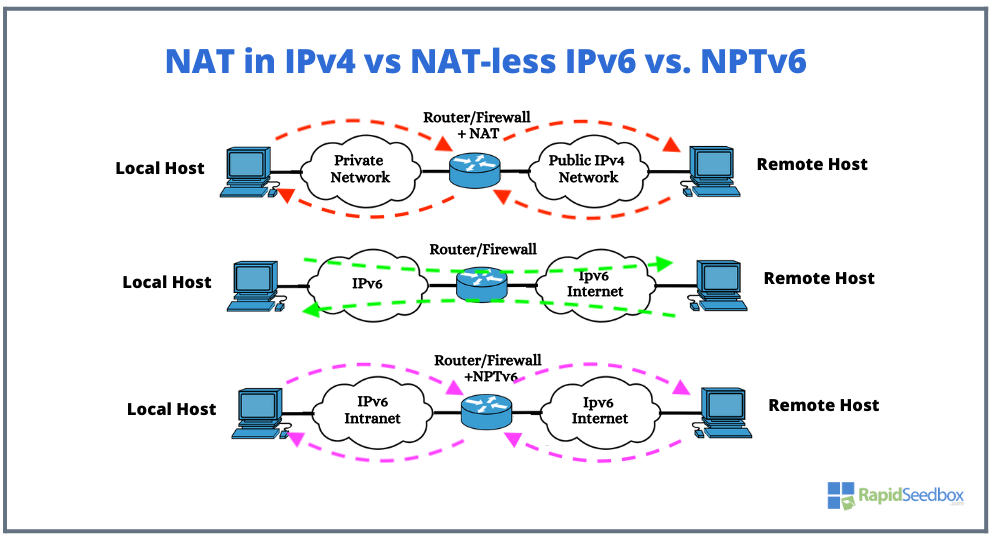Why is NAT not needed in IPv6? NAT is not needed in IPv6 addresses because IPv6 has a vast address space. This allows direct communication between devices, simplifying networks and improving security.
Want more details?
Continue reading.
In this article, we will explore NAT in the context of IPv4, how it works, and what IPv6 does to eliminate its need. Plus, we will also explore a few solutions for those that need IPv6 but still rely on NAT.

جدول المحتويات
- Understanding NAT in the Context of IPv4
- Why is NAT not needed in IPv6?
- Vast Address Space
- Enhanced Security
- Straightforward Connectivity and Network Design
- Alternative Solutions to NAT in IPv6
- Frequently Asked Questions (FAQ)
- Conclusions.
1. Understanding NAT in the Context of IPv4
IPv4 has a 32-bit address structure, which allows 4.3 billion unique addresses. A big number if you think about it. But sadly, up to this date, that number (that IPv4 provides) is not big enough to serve the growing internet. The IP scientists from the 80s knew about this, so they introduced IPv6 to “someday” replace IPv4.
So, IPv6 has a 128-bit address system. This means that IPv6 covers a much larger address space than IPv4 (IPv6 vs IPv4). For now (and for a long time), IPv6 will solve the address shortage issue and make it easier to route and manage networks.
But rolling out IPv6 in the entire Internet is easier said than done (IPv6 Migration and Benefits). There are literally billions of services, devices, and applications, that still communicate with each other with IPv4. So, NAT (Network Address Translation) or also known as NAT44, and other workarounds were created as temporary solutions.
a. What problem does NAT solve?
NAT (Network Address Translation) is a big deal for IPv4 networks. Routers or servers use it to translate private, local IP addresses to a public IP address and vice versa. In other words, NAT provides a way to share one public IP address with multiple devices on a local network. So, one home (many devices, many private IPs) = one public IP. There is also the Carrier-Grade NAT (CGNAT) that does this on a much larger scale. Communities, neighborhoods, and entire zones share a single public IP through a CGNAT.
As said before, the reasoning behind NAT was (as a kind of band-aid solution) to help address the shortage of IPv4 addresses. This clever design, not only saves IPv4 addresses but also adds a layer of security by hiding the internal IP addresses of local devices from the internet.
b. How NAT works for IPv4?
The following image illustrates the process of NAT in IPv4:

Local Communication: A host within a private network, with a private IPv4 address (10.0.0.1), wants to send data to a server on the internet. The router is configured with NAT to manage the traffic between the private network and the internet.
- Outgoing Packet Translation: When the host sends data to the server, the packet contains the source IP address (10.0.0.1, which is the host’s private address) and the destination IP address (200.100.10.1, which is the server’s public address). As the packet reaches the router with NAT, the router translates the source IP address from the private address (10.0.0.1) to the router’s public IP address (150.150.0.1). This translation allows the packet to be routed over the internet to the server.
- Incoming Packet Translation: When the server replies, the incoming packet has the server’s IP address as the source (200.100.10.1) and the router’s public IP address as the destination (150.150.0.1). As this packet reaches the NAT router, NAT translates the destination IP back to the private IP address of the host (10.0.0.1). Thus, the host within the private network receives the server’s response.
c. What are the limitations of NAT in IPv4?
Although NAT in IPv4 networks has its benefits, it also has its fair share of drawbacks including complexity, impeding end-to-end communication, and compatibility issues. These limitations highlight the need for more scalable solutions like IPv6.
2. Why is NAT Not Needed in IPv6?
a. Vast Address Space.
The main reason why NAT is not needed in IPv6 is because IPv6 has a huge address space (340 undecillion addresses, to be precise), which means we don’t need NAT anymore. NAT was explicitly designed for this, to conserve the limited pool of IPv4s. So, due to this huge number of available IPv6 addresses, any host or user can obtain a public IPv6 network address.
b. Enhanced Security.
Unlike IPv4, IPv6 features security as a fundamental component, not as an afterthought. IPv6 natively includes security (IPsec, end-to-end encryption, and secure neighbor discovery). This enhances overall network security and eliminates the need for NAT. NAT’s goal is to address the limitations of IPv4, and the security it provides is a byproduct of design. People simply use NAT as the defacto firewall, because it hides internal IP addresses from external threats.
ملاحظة: Keep in mind that IPv6’s built-in security is not really a replacement for NAT because IPv4 NAT hides true IP addresses behind and IPSec (which is also available for IPv4) provides encryption and authentication. In fact, from a network design point of view, IPSec and NAT could even complement each other.
c. Straightforward Connectivity and Network Design
IPv6’s emphasis on improved end-to-end connectivity and simplified network design negates the need for NAT. This approach enhances communication pathways, facilitates real-time transfers, and directs device-to-device connections across the internet, eliminating intermediaries like NAT devices (or other workarounds). IPv6 simplifies network design by using unique global addresses for devices, avoiding the complexities of address translation that are present in IPv4, which can lead to problems like double NAT and increased troubleshooting difficulties.
3. Alternative Solutions to NAT in IPv6?
While NAT isn’t required for most IPv6 deployments, there are certain use cases or network setups where NAT-like functionality is still useful. In such cases, solutions like Network Prefix Translation (NPTv6) or Port Control Protocol (PCP) can be used to achieve similar goals without the drawbacks of traditional NAT in IPv4.
ملاحظة: These solutions should be used with caution and sparingly in IPv6 networks, as the default approach is to rely on the protocol’s vast address space and end-to-end connectivity. These solutions are not replacements for NAT44, they just aim to facilitate the IPv6 and IPv4 interoperability.
- NPTv6: It is used when networks need to change the prefix of their IPv6 addresses without altering the interface identifier. NPTv6 can be used in situations like network renumbering, multi-homing, and policy enforcement.
- NAT64: It translates IPv6 addresses into IPv4 addresses. This is helpful for allowing IPv6-only networks to access resources on IPv4 networks.
- PCP: The Port Control Protocol can be used in IPv6 networks to manage how incoming packets are forwarded by a NAT device, such as a NAT64.
The following diagram illustrates the differences between NAT in IPv4 and two IPv6 scenarios.
- NAT in IPv4
- NAT-less IPv6
- Network Prefix Translation (NPTv6).

Here’s what each part of the diagram represents:
- NAT in IPv4: The first network diagram shows a local host behind a private network that is connected to a public IPv4 network through a router/firewall implementing NAT. The dashed red line with arrows indicates the translation process, and the remote host on the public network is shown as the communication target.
- NAT-less IPv6: The second part shows a local host with an IPv6 address connected directly to the IPv6 Internet without any NAT because IPv6 allows for a large number of addresses, making NAT unnecessary for address conservation. The green line with arrows indicates a direct, untranslated path between the local and remote hosts. In this scenario, each device typically has a globally unique IPv6 address, allowing for direct end-to-end communication without the need for address translation.
- NPTv6: The third part shows a local host within an IPv6 intranet behind a router/firewall that implements NPTv6, which is connected to the IPv6 Internet. NPTv6 is a mechanism to translate the prefix of an IPv6 address, similar to how NAT works in IPv4, but it keeps the host part of the address unchanged. The dashed purple line indicates the prefix translation process.
4. Frequently Asked Questions (FAQ)
a. Can you provide a real-world example illustrating the increased network efficiency achieved without NAT?
One great example is Comcast (now Xfinity), one of the biggest internet service providers in the US. They switched to IPv6 and saw a big improvement in network performance and management. Without NAT in their IPv6 architecture, routing was simpler, latency was reduced, and connectivity was improved for their customers. This shows the practical advantages of IPv6 in large-scale networks and not relying on NAT44.
b. What is NAT64?
NAT64 translates IPv6 addresses to IPv4 addresses, enabling communication between IPv6 and IPv4 devices. This protocol allows IPv6-only devices to access IPv4 resources. NAT64 bridges the IPv4-IPv6 transition, allowing IPv6-only networks to access IPv4 resources. However, it can introduce complexities such as application compatibility and address exhaustion.
c. How can IPv6 traffic bypass NAT when connecting to IPv4 networks and preserve end-to-end connectivity?
There are mechanisms in IPv6, such as Teredo and 6to4, that allow IPv6 traffic to traverse NAT devices when connecting to IPv4 networks. These mechanisms help preserve end-to-end connectivity without resorting to NAT in IPv6 networks.
5. Conclusion.
Although NAT played a vital role in keeping IPv4 alive, it now become obsolete in the IPv6 environment, where every device can have its own unique global address. This change not only streamlines connectivity but also signals a new era of internet architecture that is more efficient, secure, and ready to handle the ever-increasing number of connected devices.
With large-scale network examples and alternative solutions for transitional scenarios, the transition to IPv6 is not just a technical upgrade, but a necessary evolution for the future of global connectivity.
I disagree strongly with the notion that all IPv4 hosts are supposed to be publicly connected to the Internet. There is no provision in IPv6 that I can see that is directly applicable to RFC1918 networks that need to be connected only in a limited way to the Internet. Another problem with IPv6, there is limited to no access to it for most people who connect to the Internet. So why am I not supposed to turn IPv6 off when I don’t understand it adequately and don’t have access to it?
There is a lot of discrimination on the web about the IPv4 to IPv6 transition, why would you want to turn off IPv6 is common, and there is a failure of IPv6 to reasonably accommodate in my opinion the needs of private networks. A lot of discrimination on wanting to disable IPv6 on a server because it can’t be implemented properly, where in many cases it cannot be properly implemented.
On it’s face, a 128 bit verses 32 bit address space seems like a great thing. Not so fast, there are problems supporting that large an address space on a lot of the infrastructure that runs the Internet. Unfortunately, there isn’t an alternative like IPX that is freely available for private LANS. Novell doesn’t even want to support IPX these days even though arguably it would seem to be very reasonable to migrate IPv4 private networks using NAT to allow limited and controlled Internet connectivity to IPX and deploy an IPX to IPV6 gateway as needed, IPv4 to IPX when IPV6 isn’t available.
IPv6 was developed in a climate of everyone’s everything needs to be on some corporations server accessed over the public Internet. While the cloud has appropriate uses, I don’t want to do my taxes or hold my financial information, or other sensitive private information on someone’s insecure globally accessible server. IPv6 was never intended to address this privacy concern. As far as I can tell IPv6’s greatest strength is also it’s greatest drawback. A quintillion addresses? Not everything needs to be on the Internet though. New infrastructe is required and it will take a long time for most people to have the necessary infrastructure to even have access to or even be offered IPv6. There is also a problem of training, a lot of people don’t know how to deploy IPv6 even if they had access. I wish Linux didn’t in general have it turned on by default. It is harder than it should be to turn it off. There are a lot of bugs if you aren’t IPv6 connected or you try to turn it off in favor of IPv4 or both.